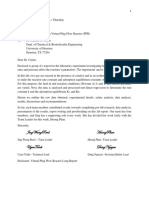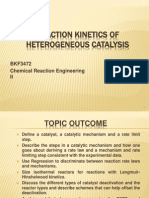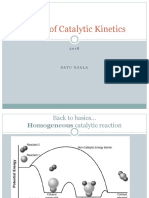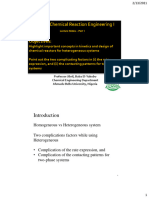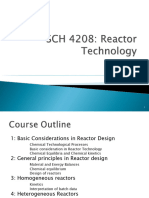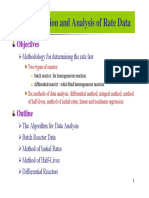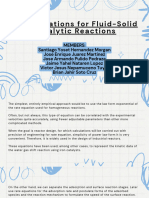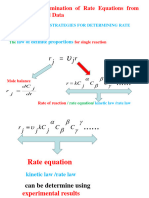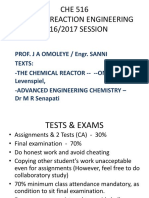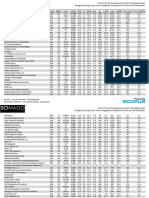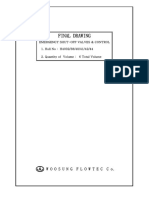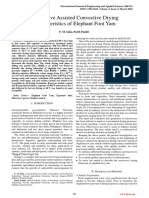Lecture 15
Uploaded by
hamaidhqaisLecture 15
Uploaded by
hamaidhqais18/05/2024
Lecture 15
Analyzing data from laboratory reactors
Dr. Enshirah Da'na 1
Objectives of analyzing data
• Determining catalyst activity, selectivity and stability.
• Determining the effect of important process variables such as
temperature, pressure, reactant concentrations.
• Finding a rate equation
Elimina?on of mass transfer and pore diffusion limita?ons
• In a solid catalyzed reaction, the presence of mass transfer and pore
diffusional resistances affect the rate of the reaction.
• To ensure that no internal or external mass transfer resistances are
present under the operating conditions, preliminary experiments are
carried out. Dr. Enshirah Da'na 2
1
18/05/2024
Elimination of mass transfer limitations
• Conversion data is obtained by increasing the flow rate of the feed but
keeping the W/FAO constant.
• At low fluid velocity, conversion increases with increasing fluid velocity
and subsequently becomes constant at higher flow rates, implying that
external mass transfer does not affect the rate of reaction at this fluid
velocity.
• Due to external mass transfer
limitation, the concentration of
reactant near catalyst surface is
lower than the bulk phase
concentration.
Dr. Enshirah Da'na 3
• The effect is maximum at lower fluid velocity when the resistance to
transport is considerable.
• With increase in fluid velocity, the turbulence effectively enhances the
mixing in fluid phase and the concentration of reactant near the
catalyst surface approaches the bulk phase concentration.
• Consequently reaction rate increases increasing the conversion.
• At high velocity due to high
turbulence the mass transfer
limita?on is totally removed and
the reactant concentra?on near the
catalyst surface becomes equal to
that of bulk phase concentra?on
and the conversion reaches the
maximum limi?ng values. Dr. Enshirah Da'na 4
2
18/05/2024
• Thereafter any change in fluid velocity does not affect the conversion
as shown in the figure. Kinetic study should always be carried out at
conditions where the effect of external mass transfer on conversion
is negligible.
Dr. Enshirah Da'na 5
Elimina?on of pore diffusion limita?ons
𝒓𝑷 𝝆𝑷
• Weisz criterion 𝑹𝟐𝑺 = ≤ 𝟏can be used to determine the
𝑪𝑺 𝑫𝒆
significance of intraparticle diffusion.
• Here Rs=pellet radius; rp = pellet density, Cs = surface concentration;
De effective diffusivity.
• Reactions should be carried out at the conditions when Weisz criterion
is satisfied so that the intraparticle diffusion could be neglected for
these operating conditions.
• The effectiveness of porous catalyst can also be determined
experimentally by measuring conversion with successively smaller
catalyst pellets until no further change in conversion occurs.
Dr. Enshirah Da'na 6
3
18/05/2024
• The pore diffusion resistance decreases the concentration within
the pellets thereby decreasing the conversion.
• The pore diffusion resistance is considered to be negligible for the
catalyst size range for which the conversion does not change with
size.
• For study of intrinsic reaction kinetics, catalyst pellet size is chosen
where the intraparticle diffusion could be neglected.
Dr. Enshirah Da'na 7
Elimination of homogeneous phase reaction and deactivation
• When reaction is carried out over a fixed bed of solid catalyst there may be
possibility of non-catalytic homogeneous reactions occurring in gas phase.
• If any non-cataly?c homogeneous reac?ons occur along with
heterogeneous cataly?c reac?ons, then data collected will give erroneous
kine?cs for the heterogeneous reac?on.
• Hence, reaction should be carried out in an empty reactor without
using any catalyst to determine the contribution of homogeneous
phase reactions, if any, at the desired operating conditions.
• Kinetic study should be carried out at operating conditions for which
contribution of homogeneous phase reactions is negligible.
Dr. Enshirah Da'na 8
4
18/05/2024
• In addition, deactivation studies should be carried out by operating
the reactor for long run lengths.
• If any significant deac?va?on occurs, than it should be taken into
account for further analysis.
Dr. Enshirah Da'na 9
Integral analysis of rate data
• A series of run are made in a packed bed at a fixed initial concentrations
CA0 and a fixed temperature T while varying the catalyst mass W and/or
initial molar flow rate FA0 to generate a range of W/FA0 values at
different conversions XA.
• A rate equation is then tested using the design equation for packed bed
reactor.
Dr. Enshirah Da'na 10
10
5
18/05/2024
• First simpler rate equations such as zero order, first order, second
order irreversible are tried.
• Mechanistic reaction models can also be tested.
• The W/FA0 and the right hand integral in equation (1) are evaluated
numerically and plotted to test for linearity (Fig 1).
• Linearity of the plot is used for judging if the selected rate equation
is a useful model for the data. If not then another rate equation may
be tried.
• If not then another rate equation may be tried.
Dr. Enshirah Da'na 11
11
Dr. Enshirah Da'na 12
12
6
18/05/2024
Differential analysis of rate data
• The data are collected as in the previous case.
• A plot of conversions XA versus W/FA0 is made for each set of runs at a
fixed temperature (Fig 2) .
• A best fit of data is made.
• Tangent to the fitted curve are drawn at regular interval along the
curve corresponding to the best fit.
• The slopes of this tangent are evaluated which correspond to the
reaction rate
13
Dr. Enshirah Da'na
13
Dr. Enshirah Da'na 14
14
7
18/05/2024
• Tangents can be evaluated more accurately by differentiating
the equation for best fit of data and evaluating the derivative at
various intervals over the data set.
• Values of –rA versus CA are plotted to determine the reaction
orders.
• For an irreversible reactions data are fitted by a simple power
rate law –rA = kCAn ,
• a plot of ln(-rA) vs lnCA is linear with a slope of order n.
• The rate constant value can be determined from the intercept.
Dr. Enshirah Da'na 15
15
• The If rate vs temperature data available then it is possible to
determine the apparent ac?va?on energy from Arrhenius equa?on k =
A exp(-E/RT).
• The slope of the plot of ln k vs 1/T gives the activation energy E
of the reaction.
Dr. Enshirah Da'na 16
16
8
18/05/2024
Dr. Enshirah Da'na 17
17
Linear and nonlinear regression of rate data
For a Langmuir –Hinshelwood type rate equation
• Parameters k, KA, KB cannot be analyzed as simply as in power law
kinetics.
• k, KA, KB can be determined by linear least square or nonlinear least
square method.
• In linear least square method, the rate equation can be linearized as:
Dr. Enshirah Da'na 18
18
9
18/05/2024
• The parameters can be estimated by multiple regression technique
using the following equation for N experimental runs.
• For the ith run:
• The best values of the parameters a0, a1 and a2 are found by solving
following three equations:
Dr. Enshirah Da'na 19
19
Dr. Enshirah Da'na 20
20
10
18/05/2024
• The LH rate equation can also be solved by non-linear regression analysis.
• Linearized analysis is used to obtain the initial estimates of the rate
parameters and used in non-linear regression.
• In non linear analysis the rate law parameters are first estimated to
calculate the rate of reaction ‘rc’.
• Then the values of rate law parameters that will minimize the sum of the
squares of difference of the measured reaction rate rm and the calculated
reaction rate rc , that is the sum of (rm-rc)2 for all data points, are searched.
Dr. Enshirah Da'na 21
21
• If there are N experiments with K number of parameter values to be
determined then the func?on to be minimized is given by:
• rim and ric are the measured and calculated reaction rate for ‘i’th run.
• The parameter values giving the minimum of the sum of squares, 𝝈2 ,
can be searched by various optimization techniques using software
packages.
Dr. Enshirah Da'na 22
22
11
18/05/2024
Initial rate analysis
• Ini?al rate analysis for a reac?on may be done to understand the
mechanism of a reac?on.
• Initial rate is the rate at zero conversion.
• It is obtained by extrapolation of the rate vs conversion data to zero
conversion.
• For higher accuracy, the conversion data are collected at very low
conversion region
• In this method, the dependence of initial rate data on partial pressure or
total pressure of the reactant is studied.
Dr. Enshirah Da'na 23
23
Consider the reaction
The rate expression derived from Langmuir Hinshelwood model when
surface reac?on is controlling is:
Now at zero conversion all the product concentration will tend to zero,
hence putting CC =0 & CD =0, the rate expression [2] simplifies to:
Dr. Enshirah Da'na 24
24
12
18/05/2024
Where ri is the initial rate. Now, if a equimolal initial concentration of
CA and CB is used then C =C . Then assuming ideal gas mixture, CA=
pA/RT where p is the partial pressure of A.
Similarly CB = PB/RT where pB is the partial pressure of B .
Now since it is an equimolal mixture, then at ini?al condi?on PA=PB =Pt/2
Then substituting CA and CB in equation [3] becomes:
Dr. Enshirah Da'na 25
25
Dr. Enshirah Da'na 26
26
13
18/05/2024
Dr. Enshirah Da'na 27
27
For this mechanism a typical plot of initial rate ri as a function of total
pressure pt is shown in Fig 4B.
When reaction data satisfy this plot then the reaction is said to be
adsorption A controlling.
In similar way other models can be tested for fitting.
It should be used as only as preliminary kinetic analysis method.
It should be used as only as preliminary kinetic analysis method.
Dr. Enshirah Da'na 28
28
14
18/05/2024
Book Reference
• J. M. Smith, Chemical Engineering Kine?cs, McGrawHill Book
Company, 1981.
• J.J. Carberry , Chemical and cataly?c reac?on Engineering, Dover
Publica?ons,2001.
• D.W.Green, R.H. Perry, Perry ś chemical engineer ś handbook, 8th
Edi?on, McGrawHill Company,2007.
• H. S. Fogler, Elements of Chemical reac?on engineering, Pren?ce
Hall of India, 1999
• R. J. Farrauto, C. H. Bartholomew, Fundamentals of Industrial
cataly?c Processes, Blackie Academic & Professional, 1997
Dr. Enshirah Da'na 29
29
15
You might also like
- Reaction Kinetics and Scale-Up of Catalytic Processes100% (1)Reaction Kinetics and Scale-Up of Catalytic Processes6 pages
- CL 308: Chemical Reaction Engineering - Ii: (Jan - May 2019)No ratings yetCL 308: Chemical Reaction Engineering - Ii: (Jan - May 2019)83 pages
- Jingwangreed Huongphan Uyentrinh Dungnguyen: Jing Wang-Reed - Team Leader Huong Phan - Team LeaderNo ratings yetJingwangreed Huongphan Uyentrinh Dungnguyen: Jing Wang-Reed - Team Leader Huong Phan - Team Leader17 pages
- Introduction To Reaction Engineering KineticsNo ratings yetIntroduction To Reaction Engineering Kinetics18 pages
- Unit-2A - Solid Catalyzed Reactions Chapter 18No ratings yetUnit-2A - Solid Catalyzed Reactions Chapter 1852 pages
- Chapter 1 - Reaction Kinetics of HeterogenousNo ratings yetChapter 1 - Reaction Kinetics of Heterogenous68 pages
- Chemical Kinetics and Reactor Design Course Review: 1 StoichiometryNo ratings yetChemical Kinetics and Reactor Design Course Review: 1 Stoichiometry5 pages
- Lab 1.1 Theory - Reaction Kinetic Studies in A Batch ReactorNo ratings yetLab 1.1 Theory - Reaction Kinetic Studies in A Batch Reactor3 pages
- Collection and Analysis of Rate Data: ObjectivesNo ratings yetCollection and Analysis of Rate Data: Objectives18 pages
- Solid Catalyzed Reactions: Prof. Anand TiwariNo ratings yetSolid Catalyzed Reactions: Prof. Anand Tiwari56 pages
- Catalysis and Catalytic Reactions: A. Sarath BabuNo ratings yetCatalysis and Catalytic Reactions: A. Sarath Babu77 pages
- Catalysis and Catalytic Reactions: A. Sarath BabuNo ratings yetCatalysis and Catalytic Reactions: A. Sarath Babu77 pages
- Kinetic Modeling of Catalytic Reactions: Short Reference OnNo ratings yetKinetic Modeling of Catalytic Reactions: Short Reference On24 pages
- Principles of Catalysis: Part 1c: DiffusionNo ratings yetPrinciples of Catalysis: Part 1c: Diffusion29 pages
- Bimolecular Following Langmuir-Mechanism: Rates of Heterogeneous Reactions The HinshelwoodNo ratings yetBimolecular Following Langmuir-Mechanism: Rates of Heterogeneous Reactions The Hinshelwood2 pages
- Vicariate of St. Augustine of Hippo Vicariate Pastoral CouncilNo ratings yetVicariate of St. Augustine of Hippo Vicariate Pastoral Council3 pages
- EagleBurgmann DMS TSE E3 Brochure Mechnical Seal Technology and Selection en 22.07.2015No ratings yetEagleBurgmann DMS TSE E3 Brochure Mechnical Seal Technology and Selection en 22.07.201558 pages
- Manufacturing Method For Porous Ammonium Nitrate100% (1)Manufacturing Method For Porous Ammonium Nitrate14 pages
- Manual Testing - Common Interview QuestionsNo ratings yetManual Testing - Common Interview Questions31 pages
- The Role of Community Policing in Crime Reduction Comparative Analysis of South Africa and KenyaNo ratings yetThe Role of Community Policing in Crime Reduction Comparative Analysis of South Africa and Kenya3 pages
- Courses Offers in The Department of Quantity SurveyingNo ratings yetCourses Offers in The Department of Quantity Surveying4 pages
- 15 AI Applications - Use Cases - Examples in Logistics in 2021No ratings yet15 AI Applications - Use Cases - Examples in Logistics in 202116 pages
- A Comprehensive Review of Seven Steps To A ComprehNo ratings yetA Comprehensive Review of Seven Steps To A Compreh7 pages
- Problems of Young Entrepreneurs ArticleNo ratings yetProblems of Young Entrepreneurs Article10 pages
- Microwave Assisted Convective Drying Characteristics of Elephant Foot YamNo ratings yetMicrowave Assisted Convective Drying Characteristics of Elephant Foot Yam9 pages











